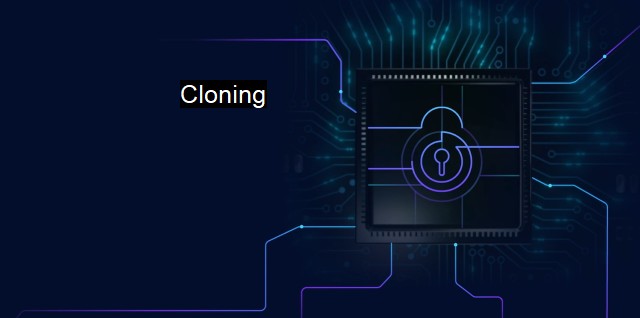What is Cloning?
Unmasking the Dangers of Cloning in Cybersecurity and Antivirus Software: Understanding the Perils of Malware and Disk Cloning Techniques
Cloning refers to the creation of duplicates or copies of systems, files, or data bits, typically for malicious or deceptive purposes. It's also known as Data Cloning or Disk Cloning when used as a legitimate mechanism to replicate data across computer systems or networks. the main focus here is to understand how cloning impacts the domain of cybersecurity and contributes to various threats, cybercrimes, and vulnerabilities.Cloning isn't inherently malicious. We live in a digital age where data is constantly being cloned for backups, updates, sharing, and networking. For instance, when a software program is installed onto a computer, it creates a clone of the original data via the hard disk that enables the computer to run the application. In this sense, cloning can be an essential component of digital processing and information technology.
Malicious cloning by threat actors poses significant cybersecurity risks. Criminals may clone servers or computer systems to gain unauthorized access to secure, sensitive areas of a network or to facilitate a ‘man-in-the-middle’ attack where data is intercepted and possibly altered in transit. Tools have been developed to automate this malicious cloning process, allowing even relatively unskilled cybercriminals to launch sophisticated attacks.
Another common malicious cloning practice is clone phishing. This involves cloning or duplicating a legitimate email, website, or communication and altering sections to bait an individual into surrendering their personal information. Victims may be tricked into updating their passwords or credit card details onto malicious websites identical in appearance to authentic ones – they are essentially perfect clones.
The advent of cloning has grave implications on antivirus measures. Antivirus software relies heavily on recognizing patterns from known malware to mitigate threats. cloned malware, much like biological viruses, often slightly modify themselves to dodge known patterns in regular antivirus updates. This replication strategy is largely successful at outpacing regular antivirus updates, severely impairing the effectiveness of many established cybersecurity approaches.
Given these risks, there is a pressing need for more advanced methods of detection and defense, and these are, indeed, being developed. There's a growing reliance on more sophisticated algorithms, artificial intelligence, and machine learning to detect and disrupt cloned threats. These modern solutions can recognize even subtle alterations in cloned files and quickly adapt to new attack strategies.
With the evolution of cloning technology, the cybersecurity landscape needs to provide equal footing continually. Antivirus systems must incorporate smarter algorithms and an updated database to tackle cloned malware. They must also educate users about the prevalence and sophistication of cloned phishing schemes.
Combating cloning also necessitates a comprehensive response. As well as resilient technologies, rigorous security protocols, personal cybersecurity hygiene, and regular system checks are necessary. the investment in cyber threat intelligence to survey and analyze evolving threats of cloning becomes a crucial cornerstone in securing an individual's information infrastructure.
Cloning in cybersecurity is a dual-faced concept. While it serves as a legitimate channel for data backup and replication, in the wrong hands it can result in rogue servers, cloned phishing attacks, and complicated antibody-escaping malware. Thus, it's essential in the antivirus realm to incessantly refine defense mechanisms to perceive, stop, and remove the threats tied to cloning.

Cloning FAQs
What is cloning in the context of cybersecurity?
Cloning in cybersecurity refers to creating a replica of an existing entity or device such as a computer, phone, or server to impersonate it or gain unauthorized access to it.What are the risks associated with cloning in cybersecurity?
Cloning poses significant risks to the security and integrity of information systems, networks, and devices. Cybercriminals can clone legitimate devices to bypass security measures such as firewalls, antivirus software, and authentication mechanisms.How can I protect my devices and network from cloning attacks?
To protect your devices and network from cloning attacks, you should implement robust security measures such as using strong passwords, two-factor authentication, and encryption. Additionally, you should regularly update your antivirus software and ensure that your software and systems are up-to-date with the latest security patches.What are some common tools and techniques used in cloning attacks?
Common tools and techniques used in cloning attacks include cloning software like Ghost or Clonezilla, hardware-based cloning devices, and social engineering tactics such as phishing and pretexting. Cloning attacks may also involve stealing or cloning MAC addresses, IP addresses, and other identifying information to impersonate legitimate devices. It is essential to remain vigilant and educated about these techniques to prevent cloning attacks.| | A | | | B | | | C | | | D | | | E | | | F | | | G | | | H | | | I | | | J | | | K | | | L | | | M | |
| | N | | | O | | | P | | | Q | | | R | | | S | | | T | | | U | | | V | | | W | | | X | | | Y | | | Z | |
| | 1 | | | 2 | | | 3 | | | 4 | | | 7 | | | 8 | | |||||||